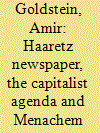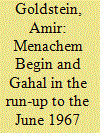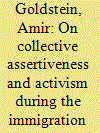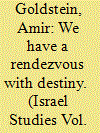|
|
|
Sort Order |
|
|
|
Items / Page
|
|
|
|
|
|
|
| Srl | Item |
| 1 |
ID:
183748


|
|
|
|
|
| Summary/Abstract |
The Zionist-Israeli Right and the Kibbutz Movement have shared a longstanding and powerful historical rivalry, but their interrelationships were more complex than presented in historiography and recollected in public consciousness. This article seeks to systematically lay out, for the first time, the interfaces between Menachem Begin, the parties under his leadership and the kibbutzim. The discussion will focus on two periods: the first, which has received almost no attention in historiography – the late 1960s and early 1970s – a phase characterized by rapprochement and reconciliation between the leader of the Israeli right-wing party and the Kibbutz Movement. The second, the stage following the political ‘upheaval’ (1977) is better-known but has not yet been thoroughly researched. This period is characterized by an escalation in the relationship between the Likud, Prime Minister Menachem Begin and the Kibbutz Movement. The article examines the contribution of both sides to this escalation, as well as the various economic, social, and political contexts within which it was manifested and its place in Israel’s political history at large.
|
|
|
|
|
|
|
|
|
|
|
|
|
|
|
|
| 2 |
ID:
183983


|
|
|
|
|
| Summary/Abstract |
The ‘Movement for the Entire Land of Israel’, was formed by activist members of the Labour movement shortly after the June 1967 war. Its founders struggle for “Greater Israel” and espoused the establishment of settlements that would secure the Israeli hold on the territories occupied during the war. During the 1970s, however, the movement had effectively come to be spearheaded by Gush Emunim (Bloc of the Faithful), a newly-created religious-nationalist activist group. This article describes this transition while examining the factors that enabled this process despite the two groups’ very different political, social, cultural ideals and intergenerational backgrounds.
|
|
|
|
|
|
|
|
|
|
|
|
|
|
|
|
| 3 |
ID:
158161


|
|
|
|
|
| Summary/Abstract |
During the 1960s, the Haaretz newspaper was a staunch supporter of the key political decisions made by Menachem Begin, thus playing a significant role in reinforcing his legitimacy and that of his Herut movement. On the one hand, this support was motivated by the desire to transform Israel’s socialist economy into a freer and less government-controlled market. On the other hand, it stemmed from the aspiration to democratise Israel’s political life. This symbiosis began to emerge in the early 1960s and was sustained over a lengthy period of time, thus underscoring the role played by Israeli bourgeois-liberal circles in the Zionist Right’s path to power.
|
|
|
|
|
|
|
|
|
|
|
|
|
|
|
|
| 4 |
ID:
154870


|
|
|
|
|
| Summary/Abstract |
This article seeks to add another dimension to the growing and extensive research on right-wing Zionism, by returning to an era when the Likud was first created. I will examine the major difference between processes that have led to the two key landmarks in the formative years of the Right in Israel: the establishment of Gahal in April 1965 and the founding of the Likud in August–September of 1973. While Gahal's establishment was a product of a prolonged, determined, patient and conscious effort on the part of Menachem Begin, the establishment of the Likud was, to a considerable degree, forced upon him. Those who were interested in expanding Gahal and creating an alignment of centre-right parties were actually the factors outside Herut, while Herut's more veteran leadership disapproved of these attempts. Within the Herut Movement, the voices that called for the creation of a broad political alignment were those that came from Herut's ‘internal opposition’, which revolved around Ezer Weizman. The article analyses the reasons behind Begin's reservations about a continued right-wing merger, examines the negotiation process and sheds light on the oscillation in Menachem Begin's ideology and politics between the fundamental and the pragmatic poles.
|
|
|
|
|
|
|
|
|
|
|
|
|
|
|
|
| 5 |
ID:
154057


|
|
|
|
|
| Summary/Abstract |
This article discusses the causes and processes that drove Menachem Begin and his Gahal party into the Israeli cabinet during the three-week waiting period preceding the June 1967 war (or Six Day War as it is commonly known). A close examination of Begin’s behaviour reveals a calculated political move aimed at exploiting deep processes within the Israeli political establishment in general, and its right-wing factions in particular. This sheds fresh light on a number of key events preceding the war, notably Prime Minister Levi Eshkol’s surrender of the defence portfolio to Moshe Dayan, as well as on the deeper processes that led within a decade to the Likud’s (Gahal’s successor) rise to power, for the first time in Israel’s history.
|
|
|
|
|
|
|
|
|
|
|
|
|
|
|
|
| 6 |
ID:
183888


|
|
|
|
|
| Summary/Abstract |
This paper has sought to examine Menachem Begin’s considerations on the issue of the settlements in the territories occupied by Israel in the decade prior to his becoming prime minister. In those years, the gap between what Begin defined as the role of his party—the gatekeeper against an Israeli withdrawal from the West Bank—vis-à-vis its actual scanty settling activity was striking. The core of the article tackles the repeated attempts made by a group of youths involved with right-wing circles to establish a Jewish settlement in or adjacent to Nablus, from 1969 to 1970. The little aid that Begin extended to these almost unknown youths sheds light on some significant facets of his perspective on the settlements. At that stage of his political career, Begin held a legalistic position and distanced himself from any unlawful clashes with the government. Begin’s adamant standpoint was consistent until the first attempt made by the religious Zionist youths to establish a settlement near Nablus in the spring-summer of 1974. Begin changed his mind only upon realizing that the clash between the settlers and the government in the summer of 1974 did not generate a noticeable public uproar.
|
|
|
|
|
|
|
|
|
|
|
|
|
|
|
|
| 7 |
ID:
164906


|
|
|
|
|
| Summary/Abstract |
This article focuses on the ways in which over 200 families of Yemenite immigrants, who founded the city of Kiryat Shmona, the development town situated at the edge of Israel's Northern District, functioned as a group during the immigration process. This case study coincides with the trend – within research of mass immigration to Israel – that relates the historical narrative through the perspective of the immigrant and settler groups, rather than from the vantage point of the establishment in charge of their absorption. The affair could have gone down in the annals of history as a story of weakness and victimhood: hundreds of immigrants were sent off to settle in an outlying peripheral region and were compelled to integrate into an environment where the financially and political-powerful kibbutzim were preponderant. Yet the Yemenite immigrants of Kiryat Shmona turned out to be a consolidated, opinionated, fighting and stubborn force that succeeded, in trying conditions, to assert their voice, struggle for their values and identity, affect major changes within the immigration–absorption system.
|
|
|
|
|
|
|
|
|
|
|
|
|
|
|
|
| 8 |
ID:
102731


|
|
|
|
|
| Publication |
2011.
|
| Summary/Abstract |
The struggle between the workers' parties and the right-wing Revisionists took an increasingly central place in Zionist history beginning in the 1930s. The Labor Movement gained political hegemony during the period of the Yishuv (pre-state Israel). When Jabotinsky tried to challenge Mapai's power position he suffered a bitter defeat. Most of Israel's first 13 years were marked by political polarity between Mapai and the Herut Movement (the latter led by Begin). Herut received a thrashing in the Knesset elections in 1951 and the General Zionists (GZ) became the second largest party after riding on the wave of middle class protest against the Mapai led government austerity regime. However, it failed to exploit its broad support into a permanent electoral base that would transform the right-center bourgeoisie into a political force that would serve as an alternative to Ben-Gurion's government. In the summer of 1955, Herut replaced the GZ as the second largest Knesset party, and in 1959, Begin became head of the opposition after Herut won 17 seats, twice as many votes garnered by the GZ, which was reduced to its political size of the first Knesset elections in 1949. The key political rivalry returned to the power struggle between the Zionist left and the nationalist right.
|
|
|
|
|
|
|
|
|
|
|
|
|
|
|
|
| 9 |
ID:
158079


|
|
|
|
|
| Summary/Abstract |
The establishment of the State of Israel was a watershed moment in the history of the General Zionists movement. The ending of the British Mandate – characterized by its responsiveness to private enterprise – symbolized the denouement of a regulatory strategy era as an exclusive modus operandi for the general organizations. The transfer of power to a participatory Jewish democracy, whereby independent institutions drew on electoral support, required that bourgeois and petit-bourgeois leaders relinquish their reservations about the political-partisan game. For the first time, they sought to gain ascendancy over a political party in the hope that it would stand up for the rights and interests of the middle class. This article will analyze the formation process of the center party and its attempt to become a significant factor in Israeli society.
|
|
|
|
|
|
|
|
|
|
|
|
|
|
|
|
|
|
|
|
|